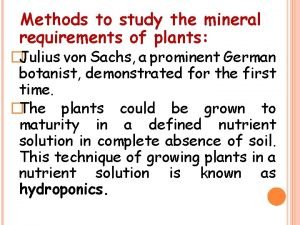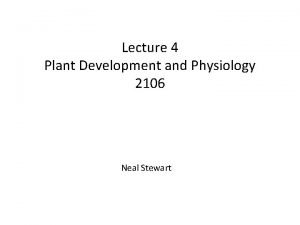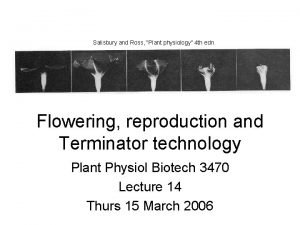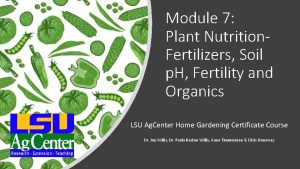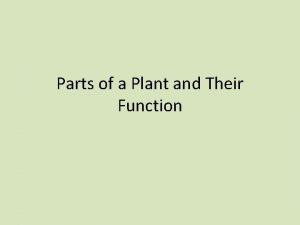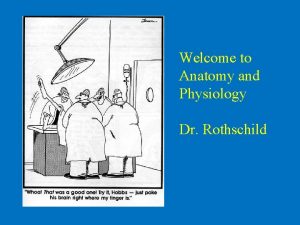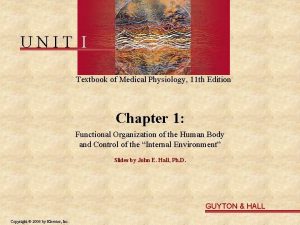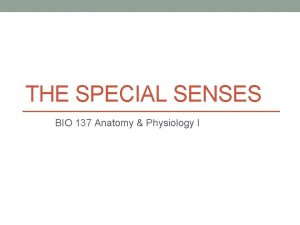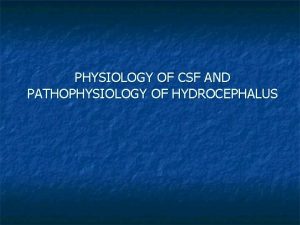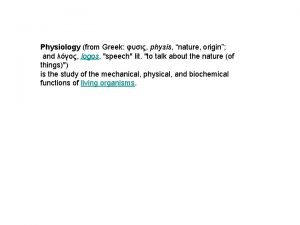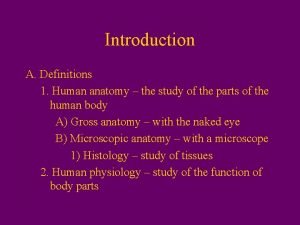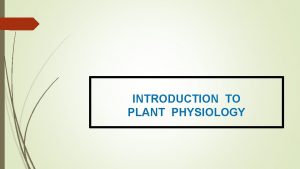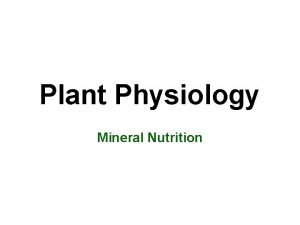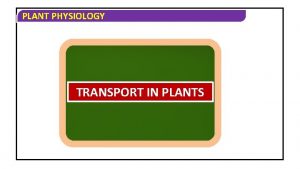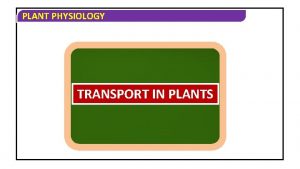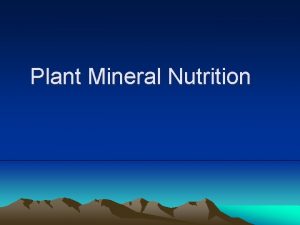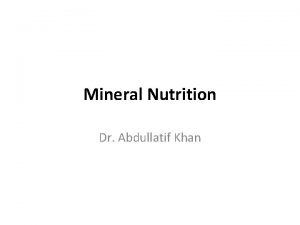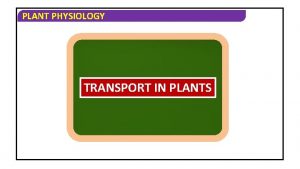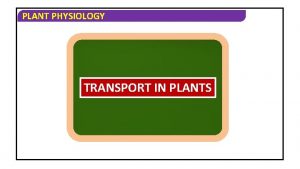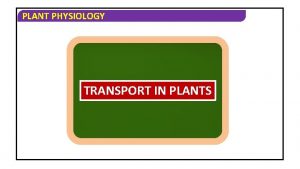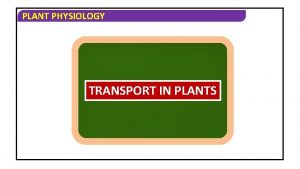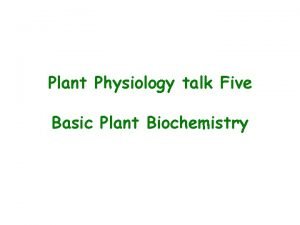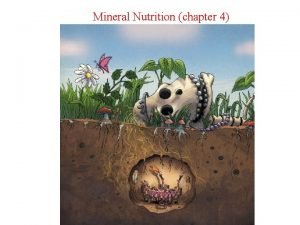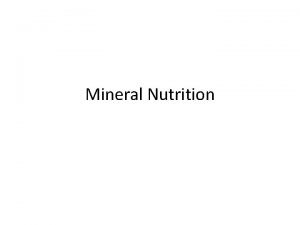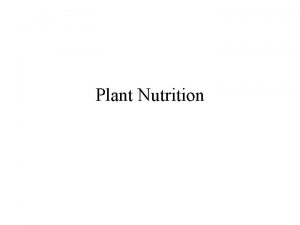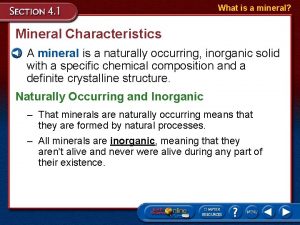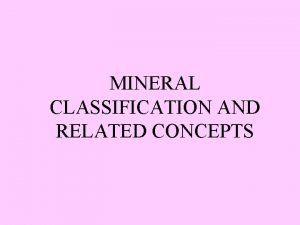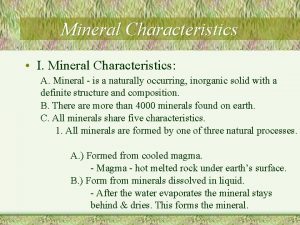Plant Physiology talk Four Mineral Nutrition Mineral Nutrition












































- Slides: 44

Plant Physiology talk Four Mineral Nutrition

Mineral Nutrition in plants • Plants are: • Capable of making all necessary organic compounds from inorganic compounds and elements in the environment (autotrophic) • Supplied with all the carbon, hydrogen, and oxygen they could ever need (CO 2, H 2 O) • Required to obtain all other elements from the soil so in a sense plants act as soil miners.

Mineral Nutrition in plants • The study of how plants obtain, distribute, metabolize, and utilize mineral nutrients. • “Mineral”: An inorganic element – Acquired mostly in the form of inorganic ions from the soil • “Nutrient”: A substance needed to survive or necessary for the synthesis of organic compounds

Mineral Nutrition How plants acquire and use mineral nutrients • Why is mineral nutrition important? • What are the essential mineral nutrients? • classification systems • Mineral nutrients in the soil • nutrient availability • adsorption to soil particles • effects of p. H • Roots and mineral nutrient acquisition • root structure • depletion zones • Mycorrhizae • Nitrogen - the most limiting soil nutrient

Why is mineral nutrition important? Fertilization increases crop production Crop Yield, tons/hecta re Fertilizer used, kg/hectare

Why is mineral nutrition Add more fertilizer nitrogen, get moreimportant? crop production. Fertilization increases crop production Crop Yield, tons/hect are Nitrogen added, kg/hectare

Plants require nine macronutrients and at least eight micronutrients • An essential nutrient is a particular chemical element that is required for a plant to grow from a seed and complete the life cycle. – 17 elements are essential nutrients

Essential plant nutrients

The symptoms of a mineral deficiency depend on the function and mobility of the nutrient in the plant • For example, a magnesium deficiency, an ingredient of chlorophyll, causes yellowing of the leaves, or chlorosis. • Iron may also be a culprit. From the wikimedia free licensed media file repository

Classifying mineral nutrients • Amount required or present in plant tissue • Metabolic need for the mineral nutrient • Biochemical function(s) for the mineral nutrient • Mobility within the plant

Mineral macronutrients

Mineral micronutrients

Nutrient deficiencies Mineral nutrient deficiencies occur when the concentration of a nutrient decreases below this typical range • Deficiencies of specific nutrients lead to specific visual, often characteristic, symptoms reflective of the role of that nutrient in plant metabolism

Nutrient deficiency v. sufficiency

Patterns of deficiency • The location where a deficiency reflects the mobility of a nutrient • Nutrients are redistributed in the phloem • Old leaves = mobile • Young = immobile

Essentiality of mineral nutrients Essential: Universal for all plants • – Absence prevents completion of life cycle • – Absence leads to deficiency • – Required for some aspect of mineral nutrition • Beneficial: Often limited to a few species • – Stimulates growth and development • – May be required in some species • – Examples: Na, Si, Se

Essentiality of mineral nutrients • There are four basic groups: • Group one: – Forms the organic components of plants – Plants assimilate these nutrients via biochemical reactions involving oxidation and reduction • Group two: – Energy storage reactions or maintaining structural integrity – Present in plant tissue as phosphate, borate or silicate esters – The elemental is bound to OH group of an organic molecule

Biochemical functions of mineral nutrients

Essentiality of mineral nutrients • Group three: – Present in plant tissue as either free ions or ions bound to substrates such as the pectin component of the plant cell wall – Of particular importance are their roles as – Enzyme cofactors – In the regulation of osmotic potentials

Biochemical functions of mineral nutrients

Essentiality of mineral nutrients • Group four: – This last group has important roles in reactions involving electron transfer. – Some also involved in the formation of plant growth hormones – Zinc – The light reaction of photosynthesis - Copper

Biochemical functions of mineral nutrients

How are mineral nutrients acquired by plants? Uptake through the leaves • Artificial: called foliar application. Used to apply iron, copper and manganese. • Associations with mycorrhizal fungi • Fungi help with root absorption • Uptake by the roots

The soil affects nutrient absorption • p. H affects the growth of plant roots and soil microbes • Root growth favors a p. H of 5. 5 to 6. 5 • Acidic conditions weathers rock and releases potassium, magnesium, calcium, and manganese. • The decomposition of organic material lowers soil p. H. • Rainfall leaches ions through soil to form alkaline conditions

The soil affects nutrient absorption • Negatively charged soil particles affect the absorption of mineral nutrients • Cation exchange occurs on the surface of the soil particle • Cations (+ve charged ions) bind to soil as it is –ve charded • If potassium binds to the soil it can displace calcium from the soil particle and make it available for uptake by the root

Plant roots – the primary route for mineral nutrient acquisition • Meristematic zone – Cells divide both in direction of root base to form cells that will become the functional root and in the direction of the root apex to form the root cap • Elongation zone – Cells elongate rapidly, undergo final round of divisions to form the endodermis. Some cells thicken to form casparian strip • Maturation zone – Fully formed root with xylem and phloem – root hairs first appear here

Root absorbs different mineral ions in different areas • • • Calcium – Apical region Iron – Apical region (barley) – Or entire root (corn) Potassium, nitrate, ammonium, and phosphate – All locations of root surface • In corn, elongation zone has max K accumulation and nitrate absorption – In corn and rice, root apex absorbs ammonium faster than the elongation zone does – In several species, root hairs are the most active phosphate absorbers

Why should root tips be the primary site of nutrient uptake? • Tissues with greatest need for nutrients – Cell elongation requires Potassium, nitrate, and chlorine to increase osmotic pressure within the wall – Ammonium is a good nitrogen source for cell division in meristem – Apex grows into fresh soil and finds fresh supplies of nutrients • Nutrients are carried via bulk flow with water, and water enters near tips • Maintain concentration gradients for mineral nutrient transport and uptake

Root uptake soon depletes nutrients near the roots • Formation of a nutrient depletion zone in the region of the soil near the plant root – Forms when rate of nutrient uptake exceeds rate of replacement in soil by diffusion in the water column – Root associations with Mycorrhizal fungi help the plant overcome this problem

Mycorrhizal associations • Not unusual – 83% of dicots, 79% of monocots and all gymnosperms • Ectotrophic Mycorrhizal fungi – Form a thick sheath around root. Some mycelium penetrates the cortex cells of the root – Root cortex cells are not penetrated, surrounded by a zone of hyphae called Hartig net – The capacity of the root system to absorb nutrients improved by this association – the fungal hyphae are finer than root hairs and can reach beyond nutrient-depleted zones in the soil near the root

• Vesicular arbuscular mycorrhizal fungi – Hyphae grow in dense arrangement , both within the root itself and extending out from the root into the soil – After entering root, either by root hair or through epidermis hyphae move through regions between cells and penetrate individual cortex cells. – Within cells form oval structures – vesicles – and branched structures – arbuscules (site of nutrient transfer) – P, Cu, & Zn absorption improved by hyphae reaching beyond the nutrient-depleted zones in the soil near the root Mycorrhizal associations

Minerals get taken up with Water • Root hairs increase surface area of root to maximize water absorption. • From the epidermis to the endodermis there are three pathways in which water can flow: • 1: Apoplast pathway: • Water moves exclusively through cell walls without crossing any membranes – The apoplast is a continuous system of cell walls and intercellular air spaces in plant tissue

Minerals get taken up with Water • 2: Transmembrane pathway: • Water sequentially enters a cell on one side, exits the cell on the other side, enters the next cell, and so on. • 3: Symplast pathway: • Water travels from one cell to the next via plasmodesmata. – The symplast consist of the entire network of cell cytoplasm interconnected by plasmodesmata

Minerals get taken up with Water • At the endodermis: • Water movement through the apoplast pathway is stopped by the Casparian Strip – Band of radial cell walls containing suberin , a waxlike water-resistant material • The casparian strip breaks continuity of the apoplast and forces water and solutes to cross the endodermis through the plasma membrane – So all water movement across the endodermis occurs through the symplast

Nutrients move from fungi to root cells • Ectotrophic Mycorrhizal – Occurs by simple diffusion from the hyphae in the hartig net to the root cells • Vesicular arbuscular mycorrhizal fungi – Occurs by simple diffusion from the arbuscules to the root cells – Also, as arbuscules are degenerating as new ones are forming, the nutrients may be released directly into the host cell

Manipulating mineral transport in plants • Increase plant growth and yield • Increase plant nutritional quality and density • Increase removal of soil contaminants (as in phytoremediation)

Leaf senescence and withdrawal of nutrients to the plant Senescence • Term for the collective process leading to the death of a plant or plant part, like a leaf. • Leaf senescence is a part of the process by which a plant goes into dormancy and is induced by a change in day length. From the wikimedia free licensed media file repository

Changing leaf color • As day length decreases, the plants ability to synthesize chlorophyll becomes reduced. • Yellow and orange carotinoids and xanthophylls, always present within the leaf, begin to show. • Water and nutrients are drawn into the stems and from the leaves. • Senescing cells also produce other chemicals, particularly anthocyanins, responsible for red and purple colors. • Some species, particularly oaks, contain high quantities of tannins in the leaves which are responsible for brown colors. From the wikimedia free licensed media file repository

Nutrient retention during senescence • In deciduous tree species some 60 – 70% of N, 60 – 70% of P, 30% of K, 25% of Mg, and 15% of Ca are withdrawn from leaves prior to them being shed. • Storage is in the bark and elements are re-mobilized in spring From the wikimedia free licensed media file repository

Leaf Abscission • The final stage in leaf senescence is abscission ("cutting off") • Abscission is controlled by a special layer of cells at the base of the petiole, the abscission layer. • This layer releases ethylene gas that stimulates production of cellulase. From the wikimedia free licensed media file repository

Leaf Abscission • This in turn breaks down cells walls so that eventually the leaf is held on to the plant only by xylem fibers. • Wind eventually weakens these and leaf falls • Another special layer of cells adjacent to the abscission layer produces cells impregnated with suberin. • These form a protective layer, which is seen as the leaf scar From the wikimedia free licensed media file repository

Essential plant nutrients Let Us Sum Up Seventeen elements are considered as essential plant nutrients for higher plants. They are generally classified based upon their relative concentration in plants. They are also classified based upon their biochemical behaviour and physiological functions. Mineral nutrients (14) are taken up by plants in ionic forms. Plant nutrients can also be classified based on their biochemical behaviour and physiological functions in plants.

Periodic table of plant mineral nutrition

The End. Any Questions?
 Talk read talk write
Talk read talk write Amateurs talk tactics professionals talk logistics
Amateurs talk tactics professionals talk logistics Problem talk vs solution talk
Problem talk vs solution talk Unit 26 agriscience
Unit 26 agriscience Unit 26 animal anatomy physiology and nutrition
Unit 26 animal anatomy physiology and nutrition Mineral nutrition in plants ppt
Mineral nutrition in plants ppt Mineral nutrition in plants ppt
Mineral nutrition in plants ppt Flippases function
Flippases function Plant celldiagram
Plant celldiagram Salisbury and ross
Salisbury and ross Ano ang likas na yaman
Ano ang likas na yaman Mobile plant safety toolbox talk
Mobile plant safety toolbox talk Advantages of fertilizers
Advantages of fertilizers Plant introduction
Plant introduction Plant breeding for disease resistance
Plant breeding for disease resistance Plant introduction in plant breeding
Plant introduction in plant breeding Tronsmo plant pathology and plant diseases download
Tronsmo plant pathology and plant diseases download Tronsmo plant pathology and plant diseases download
Tronsmo plant pathology and plant diseases download Tronsmo plant pathology and plant diseases download
Tronsmo plant pathology and plant diseases download Four organs of a plant
Four organs of a plant 4 parts of plants
4 parts of plants What is a side of a shape
What is a side of a shape Four eyes skin assessment tool
Four eyes skin assessment tool Ventral cavity
Ventral cavity Feed-forward control physiology
Feed-forward control physiology What are the special senses
What are the special senses The upper respiratory tract
The upper respiratory tract Tattoo anatomy and physiology
Tattoo anatomy and physiology The cones of the retina are coursera quiz answers
The cones of the retina are coursera quiz answers Anatomy science olympiad
Anatomy science olympiad Perfect vs imperfect flower
Perfect vs imperfect flower Physiology of speech
Physiology of speech Memory physiology
Memory physiology Physiology of hydrocephalus
Physiology of hydrocephalus Anatomy and physiology bones
Anatomy and physiology bones Definition of physiology
Definition of physiology Physiology definition
Physiology definition Gastric ulcer anatomy
Gastric ulcer anatomy Pediatric exercise physiology
Pediatric exercise physiology Microbial physiology and metabolism lecture notes
Microbial physiology and metabolism lecture notes Liver anatomy
Liver anatomy Epigastric region
Epigastric region Wpigastric region
Wpigastric region Physiology definition
Physiology definition Physiology of coitus
Physiology of coitus






